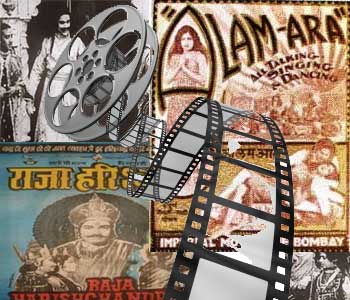

Centenary of Indian Cinema

Mega gala events, full of glitter and glamour, have begun to mark 2013 as the birth centenary of Indian cinema with the 1913 release of Dada Saheb Phalke's silent film Raja Harishchandra. However, going relatively unnoticed is the fact that 2013 is also the birth centenary of Balraj Sahni, who rode like a colossus for at least quarter of century not only on the evolution of Hindi cinema but also in the growth of popular people's culture and theatre.
Over this century, the Indian film has played an important role in shaping the collective consciousness of the people. Its various avatars ranged from providing crass entertainment designed to take people to transcend into a make believe dream world and, thus, lull their consciousness from joining the struggle for changing the injustice and sufferings of the real world to provide the vast majority of illiterate people with a philosophical meaning to understand and interpret their lives. This vast spread of the pendulum has its imprint not only on Hindi cinema but, at times more significantly, in the films produced from Calcutta and Bengal, in south Indian languages initially from Madras that now diversified into all the four southern languages and the now growing linguistic areas like Bhojpuri etc. Hence, 2013 is not merely the centenary of the Hindi cinema but it is the centenary of the Indian cinema in all its linguistic and artistic expressions.
Within the range of its vast pendulum, the Indian cinema has also played an important role as the country's collective conscience keeper. Films of Satyajit Ray, Ritwik Ghatak or Mrinal Sen among others in Bengali played an important role in this manner. Likewise the south Indian film industry did in a similar fashion. The Bengali influence soon reflected in Hindi cinema with Bimal Roy's dealing with socio-economic problems like Do Bigha Zameen (land reforms) or Sujatha (untouchability) amongst the host of others who gave a realistic character to the Indian film.
The Americans have given the world and abominable expression - collateral damage - to describe the ghastly death of innocent civilians as a result of USA's military aggressions. We can coin a reverse term - collateral benefit - to express the contribution of the political Left in India in providing to the Indian cinema this character of being the country's conscience keeper. In Hindi cinema, Balraj Sahni played a pivotal role in making such a contribution. It is, indeed, a significant coincidence that he was born on the May Day, 1913 for he remained committed to the cause of the uplift of the exploited Indian people and for the establishment of socialism in India. Born in undivided India's Rawalpindi, he studied at Government College, Lahore and decided to devote his life to journalism, which he always maintain was his first love. All those who knew him recollect that he would carry a portable typewriter to his cinema shooting sets and furiously work on a play or a script in the time that was available between the shooting of different scenes.
In his urge to free India from the colonial rule and in search of a path that combined western liberalism with Indian nationalism, he spent two years at Gurudev Rabindranath Tagore's Shantiniketan University teaching Hindi from 1937. From there, he moved to live with Mahatma Gandhi in his ashram at Wardha, Sevagram. He worked with Gandhiji, who established his constructive Nai Talim in 1939. From here, he moved on to London to work as a Hindi radio journalist and script writer for BBC from 1940-44. This was a period when the Second World War was on and the barbarity of Hitler's fascism found frequent bombing of London. From all these experiences, Balraj Sahni returned to India to join that political force which would equally fight against fascism and for India's independence. Having been already associated with the Communists in Britain, he joined the then undivided CPI and along with his wife Damayanti gave the life and spirit to the Indian People's Theatre Association (IPTA). He, thus, strove to achieve his objectives through the spread of political consciousness through art forms, particularly, theatre. The spectacular people's theatre movement he organised centering around the Bengal famine drew the most famous and well known artists into the fold of this movement. Prithviraj Kapoor used to collect money for the famine victims after IPTA's street plays. Literary giants like Mulk Raj Anand, Khwaja Ahmed Abbas, Ali Zardar Jafri, Uday Shankar, Ravi Shankar, Chittaprasod, Shambhu Mitra, S. D. Barman, Salil Chaudhury and a host of other artists who gained eminence in their respective fields.
In a film career spanning over a quarter of a century, Balraj Sahni acted in over 125 films. His performances in Bimal Roy's Do Bhiga Zameen or in Amiyo Chakraborty's Seema or Rajendra Singh Bedi's story based Garam Coat or Heman Gupta's Kabooliwala or Yash Chopra's Waqt or his last performance in M. S. Sathyu's Garam Hawa as an irritable but faithful Muslim who refuses to migrate to Pakistan during the partition continue to remain etched in the minds of my generation. Balraj Sahni died a day after he finished dubbing for this film.
The centenary celebrations of Indian cinema must also serve as the movement for introspection as to where we are headed today. The influence of big money, fancy lives and the disconnect from reality increasingly seen is a disconcerting feature that far removes Indian cinema from its role as being the country's conscience keeper. In this context, it is redeeming to see the work of today's youngsters like Himanshu Dhulia, Soorjit Sarkar, Ashutosh Gowitkar, Sudhir Mishra, Vishal Bharadwaj, Anurag Kashyap and others who are creating a new cinematic content and grammar.
*Article from the Hindustan Times, May 21, 2013
